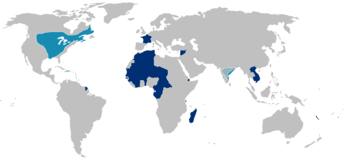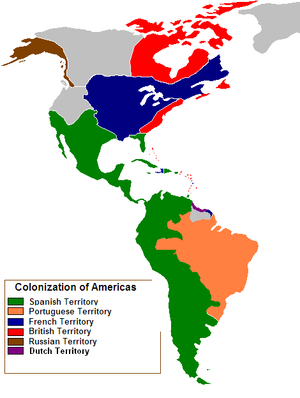This is an old revision of this page, as edited by Jayjg (talk | contribs) at 02:30, 10 July 2008 (→Who are the settlers?: remove more POV pushing - they didn't "create a society similar to the one they left", quite the opposite, and they were returning to an ancient homeland). The present address (URL) is a permanent link to this revision, which may differ significantly from the current revision.
Revision as of 02:30, 10 July 2008 by Jayjg (talk | contribs) (→Who are the settlers?: remove more POV pushing - they didn't "create a society similar to the one they left", quite the opposite, and they were returning to an ancient homeland)(diff) ← Previous revision | Latest revision (diff) | Newer revision → (diff)| This article needs additional citations for verification. Please help improve this article by adding citations to reliable sources. Unsourced material may be challenged and removed. Find sources: "Settler colonialism" – news · newspapers · books · scholar · JSTOR (May 2008) (Learn how and when to remove this message) |

Settler colonialism is a policy of conquering a land to send settlers in order to shape its demographic similarly as in the metropole. This practice contrasts with exploitation colonialism, a policy of conquering distant lands not with the intention to supplant its population, but rather to exploit its natural and human resources. A motherland might pursue the first goal in order to lighten the pressure its growing population apply to its home territory, and shape other parts of the world according to its image, thus extending its territorial continuity and preserving it indefinitely. The reasons that push a country to choose the second option are to attain more immediate benefits, extracting cheap raw materials and enslaving directly or indirectly its inhabitants.
Imperialist powers may opt for one type or the other, or both at the same time. Perhaps the most clear example of this difference is the British Empire, whose white population settled mainly North America and Oceania, exterminating in the process the native population and building modern infrastructures, and disregarded the Indian subcontinent and Africa, already densely populated. Those areas, instead, were ruled by a small colonial population, and their economies were oriented exclusively around agriculture and extraction aimed at export to the United Kingdom.
Who are the settlers?

Mostly Europeans in origin, the settlers are those who travelled from European nation-states to newly-found territories with the aim of living there permanently, creating a society similar to the one they left. Many of these countries gained greatly from their colonised territories, examples of this are the apexes of the British and the Spanish empire. While some territories gained independence and the indigenous people gained some freedoms, rarely did those liberties reach the point in which a full participation in important affairs was possible. The settlers came from the following countries:
- Portugal (Brazil, Angola, Mozambique, see Portuguese Empire)
- Spain (Latin-America except Brazil, see Spanish Empire)
- Netherlands (South Africa, Netherlands Antilles, see Dutch empire)
- France (Quebec, Algeria, Cote d'Ivoire, see French colonial empires)
- Great Britain and Ireland (United States of America, Canada, Australia, New Zealand, South Africa, see British Empire)
While some of these countries still have control over their colonial settlements, many of the territories that were once subject to the power of some other nation have now gained de jure independence. In spite of this, it might be argued that de facto independence is yet to be achieved, as ties of dependence are yet to be severed. In other cases, while those independent territories are not subject to external influence to the extent that they were before, the population of those territories still experiences considerable turmoil derived from economical disparity (see Gini coefficient) and poor living conditions derived from the past rule of a colonial power, population explosion and rampant corruption.
Racism and settler colonialism
Racism often pervaded the settlers of new territories, which in many cases resulted in the destruction, or in the best cases, complete assimilation, of the culture of the original inhabitants of the original peoples of the colonised territories.
See also: Casta, White Australia policy, Apartheid
Settler colonialism in Africa
Due to the cohesive and integrated character of white settlers in countries such as South Africa and Rhodesia, a new and complicated set of conditions that lead to exploitation of the indigenous people by the white minority was created. The elite of the country controls almost all (if not all) the relevant aspects of the political and economical life of the country. The most evident result of this domination was apartheid.
Settler colonialism in Oceania
Australia is a settler society. Europeans came and settled in Australia, in many cases displacing Indigenous Australians. The Indigenous Australian population, estimated at about 350,000 at the time of European settlement, declined steeply for 150 years following settlement, mainly because of infectious disease combined with forced re-settlement and cultural disintegration. The removal of children, that some historians and Indigenous Australians have argued could be considered to constitute genocide by some definitions, may have made a contribution to the decline in the indigenous population. Such interpretations of Aboriginal history are disputed by some as being exaggerated or fabricated for political or ideological reasons. This debate is known within Australia as the History Wars. Following the 1967 referendum, the Federal government gained the power to implement policies and make laws with respect to Aborigines. Traditional ownership of land — native title — was not recognised until 1992, when the High Court case Mabo v Queensland (No 2) overturned the notion of Australia as terra nullius at the time of European occupation.
See also: White Australia policy
Settler colonialism in Asia
Since its establishment, the People's Republic of China has encouraged settlers to live in its sparsely populated border territory, specifically in Tibet, East Turkestan and Inner Mongolia. This has been accomplished with much state assistance, for example through organisation such as the Xinjiang Production and Construction Corps. The indigenous populations of these areas, who are ethnically (and sometimes religiously) distinct from the majority Han Chinese often resent the influx of immigrants which is causing great changes in the demographics of the regions. For example, the original Mongol inhabitants are now very much in the minority in Inner Mongolia, and ethnic Tibetans and Uyghurs are already minorities in most of their cities. This resentment has often led to violence, most recently during the 2008 Tibetan unrest. The fear of being made minorities in their own countries within their lifetimes is a strong spur to the Tibetan and Uyghur separatist movements.
Settler colonialism in Israel
Several scholars have argued that Israeli Settlements (especially those which are hotly disputed) are, in fact, an instance of settler colonialism. Lorenzo Veracini, an Australian scholar from the National University in Canberra argues that Israel could celebrate its anti-colonial and anti-British struggle exactly because it was able to establish a number of colonial relationships within and without the borders of 1948.
This is so even when the possibility of an Israeli disengagement is always latent and hence could this relationship be severed, through an “accommodation of a Palestinian Israeli autonomy within the institutions of the Israeli state” (Veracini 2006). The nature of this relationship seems to be hidden or conventionally thought of as non-existent, according to Veracini, even so, this does not eliminate the fact that a colonising society is currently living in the occupied territories.
Other scholars, such as Daiva Stasiulis and Nira Yuval-Davis, have included Israel in their global analysis of settler societies (Tyrrell 2002, Adas 2001, Stasiulis and Yuval-Davis 1995).
Ambassador Rastam Mohd Isa, former permanent representative of Malaysia to the United Nations has condemned "the continuing and escalating Israeli military campaign against the Palestinian people, in particular the wilful killing of civilians, including extrajudicial executions; demolition of homes and paralyzing closures; excessive and indiscriminate use of force, and continuing settler colonial activities"
Similar opinions can be found on the Palestinian side of the conflict - Jamil Hilal, a Palestinian sociologist, writer and member of the Palestinian National Council who lives in the West Bank, draws parallels between the South African settler colonialism and Israel, arguing that "as in Southern Africa, stretches of land were acquired by the Zionist settlers and their Arab tenants thrown out". He also argues that the Israeli case has in common with South Africa a dispossession of the indigenous population of their land by Europeans.
Settler colonialism in Latin-America

In the case of Mexico, the Mexican independence movement was initiated by criollos who wanted to seize the power from the Spanish settlers. Miguel Hidalgo used banners with the slogans which included "Long live Fernando VII!, Long live the Americas and death to the corrupt government!".
Thus, the independence movement was not so much aimed at breaking off Mexico's ties to Spain as it was to seize power from a corrupt elite to claim it for a new elite in Mexico. Many years later a popular uprising would be triggered by the past existence of the castas system, a very concentrated land ownership, an economical system in which majority of the population lived in extreme poverty, and deep social unrest.
A result of the cultural heritage of the Spanish in Mexico was a deeply troubled history starting with Mexico's independence. After that, it resulted in a dominant party system, in which a single political party controlled all affairs in a ruthless and irresponsible manner for 70 years.
See also
- Global Empire
- Afrikaner
- Caldoche
- Pied-noir
- Scots-Irish American
- Overseas Chinese
- Irish diaspora
- Transmigration program
- Overpopulation
- Immigration
- First white child
Further reading
- Settler Colonialism in the Twentieth Century (edited by Susan Pedersen and Caroline Elkins, Routledge, 2005)
References
- Smith, L. (1980), The Aboriginal Population of Australia, Australian National University Press, Canberra
- Tatz, C. (1999). Genocide in Australia, AIATSIS Research Discussion Papers No 8, Australian Institute of Aboriginal and Torres Strait Islander Studies, Canberra
- Windschuttle, K. (2001). The Fabrication of Aboriginal History, The New Criterion Vol. 20, No. 1, September 20.
- b o r d e r l a n d s e-journal
- Barnes & Noble.com - Books: Unsettling Settler Societies, by Daiva Stasiulis, Paperback
- Situation in the Middle East - Palestine
- archive.lib.msu.edu/DMC/African%20Journals/pdfs/Utafiti/vol1no1/aejp001001004.pdf
- archive.lib.msu.edu/DMC/African%20Journals/pdfs/Utafiti/vol1no1/aejp001001004.pdf